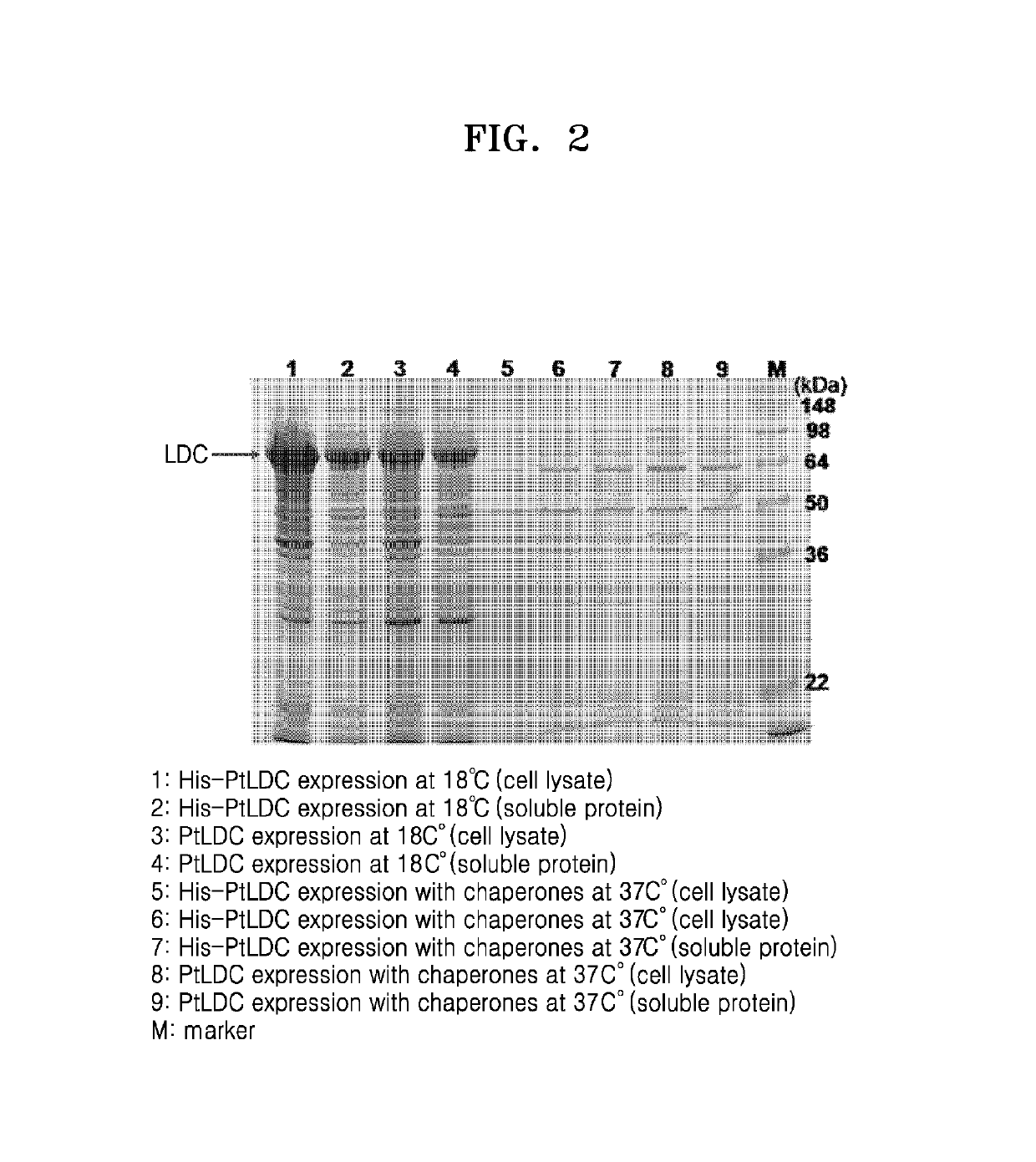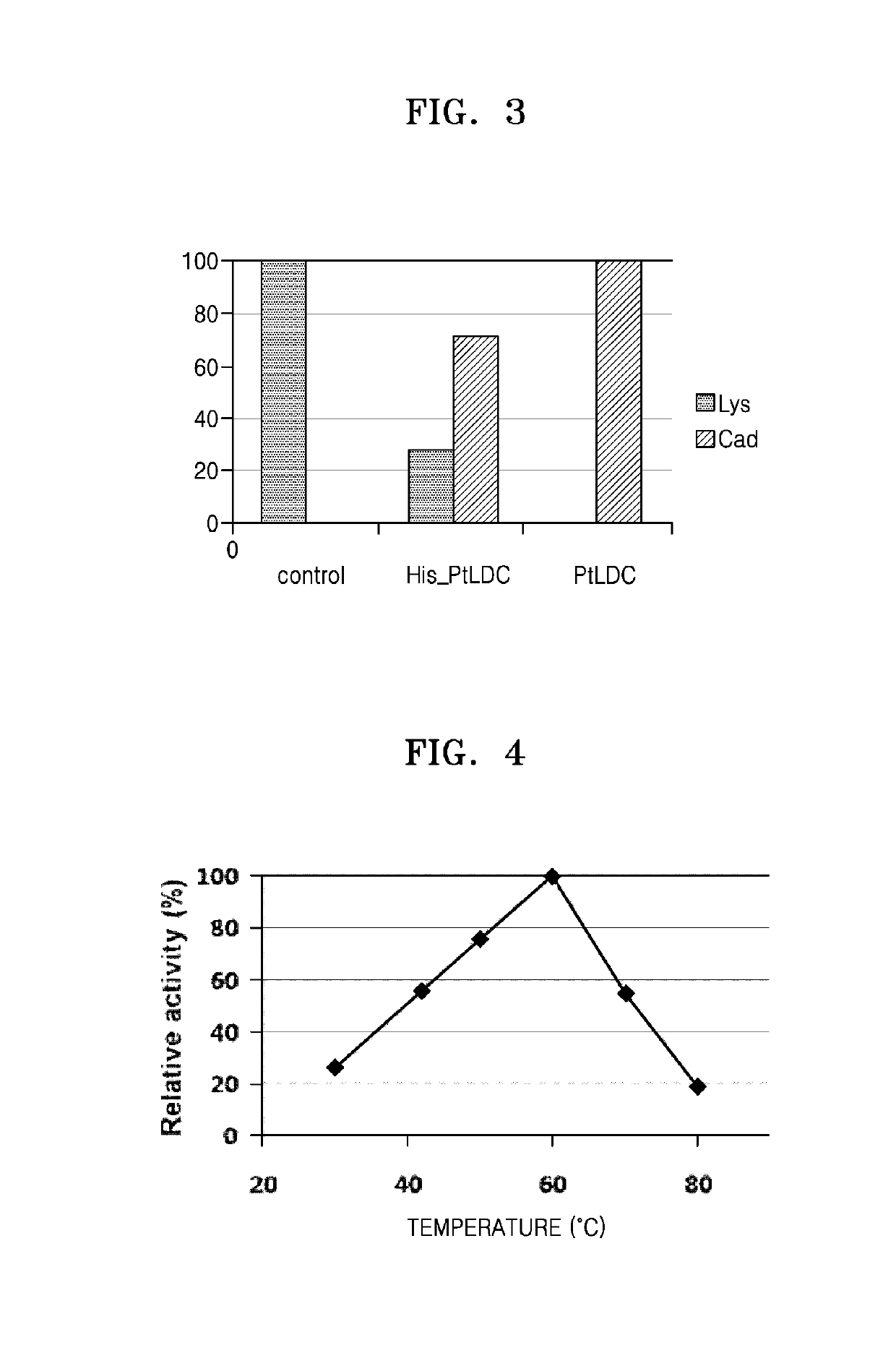Lysine decarboxylase having improved stability with a pH change, microorganism comprising a polynucleotide encoding the same, and method for producing cadaverine using the same
a technology of lysine decarboxylase and stability, which is applied in the field of new lysine decarboxylase, can solve the problems of efficiency reduction and loss of activity, and achieve the effect of stable activity and efficient us
- Summary
- Abstract
- Description
- Claims
- Application Information
AI Technical Summary
Benefits of technology
Problems solved by technology
Method used
Image
Examples
example 1
Selection of Novel Lysine Decarboxylase for Producing Cadaverine
[0065]1-1. Selection of Lysine Decarboxylase Derived from Pseudomonas Thermotolerans
[0066]To select a novel lysine decarboxylase to be used in the production of cadaverine, a BLAST program (http: / / blast.ncbi.nlm.nih.gov / Blast.cgi?PROGRAM=blastn&PAGE_TYPE=BlastSearch&LINK—LOC=blasthome) provided by the National Center for Biotechnology Information (NCBI), USA was used to search for lysine decarboxylase derived from a thermophilic bacterium which has high similarity to a peptide sequence of an active site of lysine decarboxylase derived from E. coli. In detail, a BLAST search was carried out, based on a total of 31 peptide sequences (GRVEGKVIYETQSTHKLLAAFSQASMIHVKG: SEQ ID NO: 12) each including 15 amino acids at the N-terminus and the C-terminus centered around the 367th lysine which is the main amino acid of lysine decarboxylase derived from E. coli. As a result, it was confirmed that Escherichia, Shigella, Enterobacte...
example 2
Preparation of E. coli Introduced with Lysine Decarboxylase Gene Derived from Pseudomonas Thermotolerans and Analysis of Activity of Lysine Decarboxylase Expressed Therefrom
[0071]2-1. Transformation of E. coli with Lysine Decarboxylase Gene Derived from Pseudomonas thermotolerans
[0072]To introduce the lysine decarboxylase gene derived from Pseudomonas thermotolerans into E. coli and express the gene therefrom, cloning of a recombinant gene was performed. Genetic information on Pseudomonas thermotolerans was obtained from genomic data of the NCBI (http: / / www.ncbi.nlm.nih.gov / genome / ).
[0073]The genomic DNA of Pseudomonas thermotolerans was obtained, and then used as a template to amplify a Pseudomonas thermotolerans-derived lysine decarboxylase gene (ptldc) by polymerase chain reaction (PCR). To perform PCR, primers of 5_LDC_Ndel (AATATACATATGTACAAAGACCTCCAATTCCCC) (SEQ ID NO: 13) and 3_LDC_Xhol (AATATACTCGAGTCAGATCTTGATGCAGTCCACCG) (SEQ ID NO: 14) and PfuUltra™ DNA polymerase (Strat...
example 3
Preparation of E. coli Introduced with Lysine Decarboxylase Gene Derived from Pseudomonas Alcaligenes and Analysis of Activity of Lysine Decarboxylase Expressed Therefrom
[0081]3-1. Transformation of E. coli with Lysine Decarboxylase Gene Derived from Pseudomonas alcaligenes
[0082]To clone a lysine decarboxylase gene (paldc) derived from Pseudomonas alcaligenes, primers of 5_PaLDC_Ndel (AATATACATATGTACAAAGACCTGAA GTTCCCCATCC) (SEQ ID NO: 17) and 3_PaLDC_Xhol (AATATACTCGAGTCACTCCCTTATGCAATCAACGGTATAGC) (SEQ ID NO: 18) and purified genomic DNA of Pseudomonas alcaligenes as a template were used to perform PCR. Pfu DNA polymerase was used as a polymerase, and PCR was performed for 30 cycles under conditions of 94° C.: 30 sec, 55° C.: 30 sec, and 72° C.: 2 min. As a result, an amplified paldc gene (SEQ ID NO: 4) was obtained.
[0083]The obtained paldc gene was expressed at a low temperature in E. coli in the same manner as in Example 2-1, and identified by SDS-PAGE (FIG. 6). As shown in FIG...
PUM
| Property | Measurement | Unit |
|---|---|---|
| pH | aaaaa | aaaaa |
| pH | aaaaa | aaaaa |
| temperature | aaaaa | aaaaa |
Abstract
Description
Claims
Application Information
 Login to View More
Login to View More - R&D
- Intellectual Property
- Life Sciences
- Materials
- Tech Scout
- Unparalleled Data Quality
- Higher Quality Content
- 60% Fewer Hallucinations
Browse by: Latest US Patents, China's latest patents, Technical Efficacy Thesaurus, Application Domain, Technology Topic, Popular Technical Reports.
© 2025 PatSnap. All rights reserved.Legal|Privacy policy|Modern Slavery Act Transparency Statement|Sitemap|About US| Contact US: help@patsnap.com



